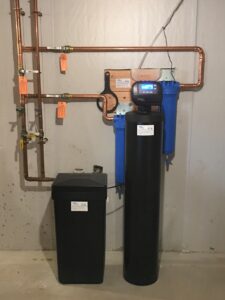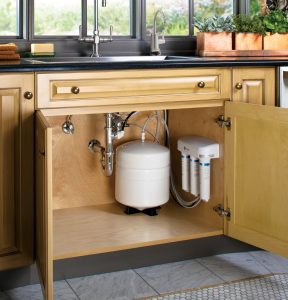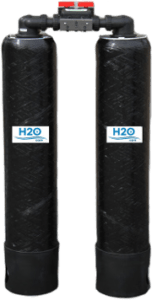
Whole house water filtration systems will address various water quality issues experienced in Woburn, Mass. Matching the right technology and sizing the system to meet the water usage demands are key. Additionally, a professionally plumbed system is critical as well as maintenance of the system throughout the years. Accordingly, this will optimize the useful life and proper functioning of your new equipment for many years.
You may see symptoms of water quality issues such as bad odors & taste, staining of laundry, bathroom fixtures, etc. While these are indicators, the best starting point is to test and identify the minerals or contaminants in the water. Consequently, this will lead to an effective system recommendation and route to providing your home with excellent water quality.
WATER SOFTENER & OTHER FILTRATION SYSTEMS

High Efficiency Water Softener
A water softener is a type of whole house water filtration system that is designed for removing hard water minerals (magnesium & calcium) as well as dissolved iron and manganese from the water. For water with high levels of iron or manganese (“the stainers”), an “up-flow” water softener is recommended to prevent mineral build-up in the bottom of the water softener. In addition, high efficiency water softeners that are more efficient with both water and salt usage are preferred.
BAD ODORS & TASTE, REVERSE OSMOSIS
Furthermore, there are many other types of systems to remove bad tastes & odors, sediment and other objectionable minerals and contaminants in the water. For example, reverse osmosis technology is a top rated approach to providing purified drinking water. See the link at https://h2ocare.com/reverse-osmosis-ro-water-pur/. For more on bad odors & taste in your water, see the link at https://h2ocare.com/bad-odortaste/.

Reverse Osmosis Purification
REMOVAL OF PFAS FROM WATER

PFAS Removal
There are technologies effective in removing PFAS from drinking water, especially Perfluorooctanoic acid (PFOA) and Perfluoro octane sulfonic acid (PFOS). These are the most studied of these chemicals. Moreover, the most effective technologies include Ion exchange, activated carbon adsorption and reverse osmosis. For more information on removal, see the link at https://h2ocare.com/what-are-pfas/.


